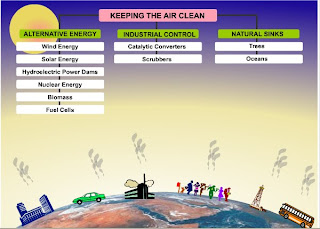First Impression
As compare to other provided teaching examples, the topic of “Air Pollution” is somehow fall into the category of General Education which may require less detailed professional terminologies when delivering the content.
The theme design with green color, plants, tall mentions, as well as animations is quite match with the idea of “Environmental protection” under “Air Pollution”, thus I would consider it as a positive point, since students are easily get into the topic and somehow know that: “Okay, we are going to studies something green.”
As compare to other provided teaching examples, the topic of “Air Pollution” is somehow fall into the category of General Education which may require less detailed professional terminologies when delivering the content.
The theme design with green color, plants, tall mentions, as well as animations is quite match with the idea of “Environmental protection” under “Air Pollution”, thus I would consider it as a positive point, since students are easily get into the topic and somehow know that: “Okay, we are going to studies something green.”
The expected outcome
At the end of the day, students are required to work on a proposal which not only contains the current air pollution facts, but also possible solutions to air pollution of which can be considered as a cognitive artifact. During the research process, students are also expecting to raise their consciousness of seriousness of air pollution. When we review the whole project based on the Basic model of Learning Activities, we can identify that both Learners and Artifact are there, but how about the tools?
Contents (cognitive tools)
I am not sure the material is prepared for senior students in primary school or secondary school students, but after I examine the contents of the whole project, I would tend to believe it is a project activity for secondary school students.
The first three parts: “About Air Pollution”, “Impact of Air Pollution” and “Keeping the air clean” are mainly stating some fact sheets about the air pollution. I suppose the cognitive tools used here are limited to some animations and concept maps.
I am not sure the material is prepared for senior students in primary school or secondary school students, but after I examine the contents of the whole project, I would tend to believe it is a project activity for secondary school students.
The first three parts: “About Air Pollution”, “Impact of Air Pollution” and “Keeping the air clean” are mainly stating some fact sheets about the air pollution. I suppose the cognitive tools used here are limited to some animations and concept maps.
The lack of tools used here may result a one-way communication between teacher and students and it will be hard for students to develop a cognitive network between all the facts of “Elements of air”, “major Elements of polluted air” and “the cause of air pollution”.
When it comes to the final project page, only a simple picture with minimum explanation is showing. I doubt students will have same question as me”Where is it?” “If I want to examine places near my home, where can I get the tools to picture the same map with spotted dots?” Furthermore, although it stated what kind of information should be included in the project, it lacks of more useful information to tell students where to find information and how to evaluate your project.
When it comes to the final project page, only a simple picture with minimum explanation is showing. I doubt students will have same question as me”Where is it?” “If I want to examine places near my home, where can I get the tools to picture the same map with spotted dots?” Furthermore, although it stated what kind of information should be included in the project, it lacks of more useful information to tell students where to find information and how to evaluate your project.
Posted by Sophie Gu Jiaying



No comments:
Post a Comment